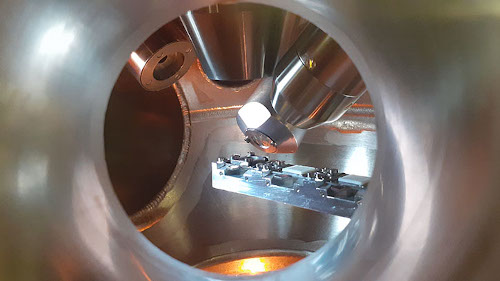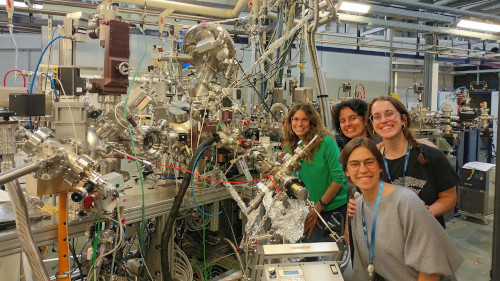Do you want to keep up to date? Subscribe to our newsletter. 1 mail every 2 months! |
 |


Left: sample being analyzed inside the analysis chamber of the X-ray photoelectron spectroscopy equipment of the Multiscale Science and Engineering Research Center of Barcelona. Right: researchers from the ENCORE-NEMEN group, performing experiments at the CIRCE-NAPP beamline of X-ray photoelectron spectroscopy at the ALBA Synchrotron.
Cerdanyola del Vallès, 21st September 2022. Methane is a primary component of natural gas, which has been promoted as a cleaner alternative to coal and petroleum-based fuels and whose use has skyrocketed in recent years. As a result, methane concentrations in the atmosphere have more than doubled since pre-industrial times.
Methane has 34 times the warming power of CO2 over 100 years and 86 times over 20 years. It is the second largest contributor to global warming. Holding global warming below 2°C as set under the Paris Agreement requires cutting not only CO2 emissions but also methane emissions. Human activities account for two-thirds of methane emissions. The rest comes from natural sources. According to a United Nations report, most human-caused methane emissions come from fossil fuels, waste and livestock. Curbing methane emissions can limit global warming in the short term, buying us time to end CO2-induced warming for good.
One of the most effective ways to remove methane is to use a catalyst that accelerates its oxidation by air. For some time, the best catalysts for removing methane used palladium nanoparticles supported on ceramic oxides. However, they stop working in the presence of water vapor, which is always present in natural gas combustion. What is the solution? Adding platinum atoms to the palladium nanoparticles. This has been studied by researchers from the Universitat Politècnica de Catalunya · BarcelonaTech (UPC), the University of Udine (Italy) and the ALBA Synchrotron. Published in Nature Communications, the study has been led by Marie Curie postdoctoral researcher Núria Jiménez Divins and current vice-rector for Research Jordi Llorca Piqué. Both of them are part of the UPC’s Department of Chemical Engineering and the Institute of Energy Technologies, affiliated with the Barcelona East School of Engineering (EEBE) on the Diagonal-Besòs Campus.
The researchers have matched the data obtained in experiments carried out at three different beamlines of the ALBA Synchrotron to study the active sites of the catalyst while in operation: X-ray photoelectron spectroscopy, X-ray diffraction and X-ray absorption. Using synchrotron light, they discovered that palladium and platinum oxidation states play a key role in methane removal, and that catalysts prepared using mechanochemical methods are more active and perfectly water-resistant. This type of catalyst—which has already been patented—is so far the most effective in the world to eliminate methane and can be applied to catalytic converters on combustion engine vehicles and to natural gas domestic boilers and turbines.
Referencia: Divins, N.J., Braga, A., Vendrell, X. et al. Investigation of the evolution of Pd-Pt supported on ceria for dry and wet methane oxidation. Nat Commun 13, 5080 (2022). https://doi.org/10.1038/s41467-022-32765-4
With the collaboration of Fundación Española para la Ciencia y la Tecnología. The ALBA Synchrotron is part of the of the Unidades de Cultura Científica y de la Innovación (UCC+i) of the FECYT and has received support through the FCT-21-17088 project.





